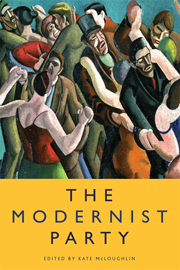Book contents
- Frontmatter
- Contents
- A Note of Thanks
- The Guest List
- Introduction: A Welcome from the Host
- 1 ‘The dinner was indeed quiet’: Domestic Parties in the Work of Joseph Conrad
- 2 Prufrock, Party-Goer: Tongue-Tied at Tea
- 3 Party Joyce: From the ‘Dead’ to When We ‘Wake’
- 4 ‘Looking at the party with you’: Pivotal Moments in Katherine Mansfield's Party Stories
- 5 Virginia Woolf's Idea of a Party
- 6 Proustian Peristalsis: Parties Before, During and After
- 7 ‘Ezra through the open door’: The Parties of Natalie Barney, Adrienne Monnier and Sylvia Beach as Lesbian Modernist Cultural Production
- 8 ‘Indeed everybody did come’: Parties, Publicity and Intimacy in Gertrude Stein's Plays
- 9 The Interracial Party of Modernist Primitivism and the Black ‘After-Party’
- 10 The Party In Extremis in D. H. Lawrence's Women in Love
- 11 Bohemian Retrospects: Ford Madox Ford, Post-War Memory and the Cabaret Theatre Club
- 12 ‘Pleasure too often repeated’: Aldous Huxley's Modernity
- Index
6 - Proustian Peristalsis: Parties Before, During and After
Published online by Cambridge University Press: 05 April 2014
- Frontmatter
- Contents
- A Note of Thanks
- The Guest List
- Introduction: A Welcome from the Host
- 1 ‘The dinner was indeed quiet’: Domestic Parties in the Work of Joseph Conrad
- 2 Prufrock, Party-Goer: Tongue-Tied at Tea
- 3 Party Joyce: From the ‘Dead’ to When We ‘Wake’
- 4 ‘Looking at the party with you’: Pivotal Moments in Katherine Mansfield's Party Stories
- 5 Virginia Woolf's Idea of a Party
- 6 Proustian Peristalsis: Parties Before, During and After
- 7 ‘Ezra through the open door’: The Parties of Natalie Barney, Adrienne Monnier and Sylvia Beach as Lesbian Modernist Cultural Production
- 8 ‘Indeed everybody did come’: Parties, Publicity and Intimacy in Gertrude Stein's Plays
- 9 The Interracial Party of Modernist Primitivism and the Black ‘After-Party’
- 10 The Party In Extremis in D. H. Lawrence's Women in Love
- 11 Bohemian Retrospects: Ford Madox Ford, Post-War Memory and the Cabaret Theatre Club
- 12 ‘Pleasure too often repeated’: Aldous Huxley's Modernity
- Index
Summary
The nature of parties has been imperfectly studied. It is, however, generally understood that a party has a pathology, that it is a kind of an individual and that it is likely to be a very perverse individual. And it is also generally understood that a party hardly ever goes the way it is planned or intended. This last, of course, excludes those dismal slave parties whipped and controlled and dominated, given by ogreish professional hostesses. These are not parties at all but acts and demonstrations, about as spontaneous as peristalsis and as interesting as its end product.
(John Steinbeck, Cannery Row)The reader might wonder whether John Steinbeck's amusing statement on ‘the nature of parties’ applies exclusively to the novel in which it appears, or whether it has a broader applicability. Cannery Row (1945), set in Monterey, California, during the Great Depression, is a concatenation of short scenes tied together by two parties – one which takes place about halfway through the book, and which is disastrous in its results, and a second one, which is planned as an act of atonement for the first one. A group of unemployed or underemployed men usually referred to as ‘The Boys’ by the narrator decide to throw a party for one of the book's main characters, a marine biologist called Doc, who has been good to them over the years. The first party's origin has an ethical dimension.
- Type
- Chapter
- Information
- The Modernist Party , pp. 112 - 126Publisher: Edinburgh University PressPrint publication year: 2013

